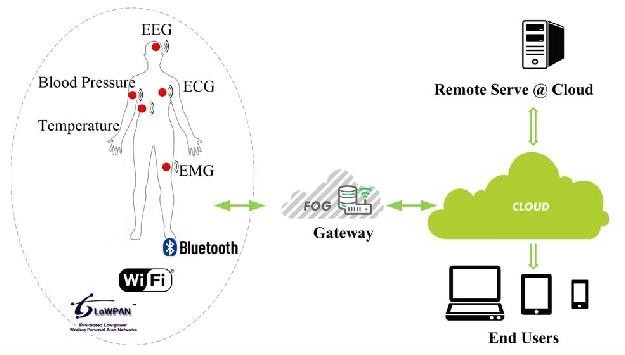IoT Enabled Sensory Monitoring System for Fog Optimal Resource Provisioning Method in Health Monitoring System
Main Article Content
Abstract
Fog is data management and analytics service. In this paper gains and most effective novel approach to provide IoT enabled services in healthcare application using Fog Computing. In this research the data is collected from Google Scholar, Science Director and MEDLINE database. IoT based Fog Computing techniques are proposed for delivering quality of services to the user. Optimal Resource Provisioning method is proposed to find edges, service level agreements and administration services for IoT client. The DeepQ residue information processing technique is applied for connecting data centre of the cloud and computing paradigms technique is finding the depth reference of Fog levels. The proposed Optimal resource provisioning algorithm is examining the dataset and TensorFlow tool is used for simulating environment. Fog computing layer consist of IoT sensor data inputs, data centres for the cloud and connected layers for simulations. The Deep belief network is generated based on above inputs using 256 X 256 X 3 layer system and 5000 trained data, 1000 test data are taken for simulations. Each dataset simulation is recording using supervised and unsupervised learning methods. Based on above results IoT enable Fog Computing data management and analytics systems provided 95% accuracy and the compared with existing computing techniques our proposed systems shows better efficiency with respect to safety and convenience.
Article Details
References
Wang X, Li Y (2020) Fog-assisted content-centric healthcare IoT. IEEE Internet of Things Mag 3(3):90–93. https://doi.org/10.1109/IOTM.0001.2000005
Isa SBM, El-Gorashi TEH, Musa MOI, Elmirghani JMH (2020) Energy efficient fog-based healthcare monitoring infrastructure. IEEE Access 8:197828–197852.
Tuli S, Basumatary N, Gill SS et al (2020) HealthFog: an ensemble deep learning based smart healthcare system for automatic diagnosis of heart diseases in integrated IoT and fog computing environments. Futur Gener Comput Syst 104:187–200.
Zhang L, Cao B, Li Y, Peng M, Feng G (2021) A multi-stage stochastic programming-based offloading policy for fog enabled IoT-eHealth. IEEE J Sel Areas Commun 39(2):411–425.
Shynu PG, Menon VG, Kumar RL, Kadry S, Nam Y (2021) Blockchain-based secure healthcare application for diabetic-cardio disease prediction in fog computing. IEEE Access 9:45706–45720. https://doi.org/10.1109/ACCESS.2021.3065440
Qiu Y, Zhang H, Long K (2021) Computation offloading and wireless resource management for healthcare monitoring in fog-computing based internet of medical things. IEEE Internet Things J. https://doi.org/10.1109/JIOT.2021.3066604
Hussain A, Zafar K, Baig AR (2021) Fog-centric IoT based framework for healthcare monitoring, management and early warning system. IEEE Access 9:74168–74179. https://doi.org/10.1109/ACCESS.2021.3080237
Jorvekar, G. N. ., Arjariya, T. ., & Gangwar, M. . (2023). Hybrid Feature Selection Techniques for Aspect based Sentiment Classification using Supervised Machine Learning. International Journal of Intelligent Systems and Applications in Engineering, 11(2s), 211 –. Retrieved from https://ijisae.org/index.php/IJISAE/article/view/2619
Kartika S. (2016). Analysis of “SystemC” design flow for FPGA implementation. International Journal of New Practices in Management and Engineering, 5(01), 01 - 07. Retrieved from http://ijnpme.org/index.php/IJNPME/article/view/41
Asghar A, Abbas A, Khattak HA, Khan SU (2021) Fog based architecture and load balancing methodology for health monitoring systems. IEEE Access 9:96189–96200. https://doi.org/10.1109/ACCESS.2021.3094033
ARECHE, F. O. ., & Palsetty , K. . (2021). Ubiquitous Counter Propagation Network in Analysis of Diabetic Data Using Extended Self-Organizing Map. Research Journal of Computer Systems and Engineering, 2(2), 51:57. Retrieved from https://technicaljournals.org/RJCSE/index.php/journal/article/view/33
Guo C, Tian P, Choo KKR (2021) Enabling privacy-assured fog-based data aggregation in E-healthcare systems. IEEE Trans Industr Inf 17(3):1948–1957. https://doi.org/10.1109/TII.2020.2995228
Ramzanpoor Y, Hosseini Shirvani M, Golsorkhtabaramiri M (2021) Multi-objective fault-tolerant optimization algorithm for deployment of IoT applications on fog computing infrastructure. Complex Intell Syst. https://doi.org/10.1007/s40747-021-00368-z
Jin W, Xu R, You T, Hong YG, Kim D (2020) Secure edge computing management based on independent microservices providers for gateway-centric IoT networks. IEEE Access 8:187975–187990. https://doi.org/10.1109/ACCESS.2020.3030297
Botha, D., Dimitrov, D., Popovi?, N., Pereira, P., & López, M. Deep Reinforcement Learning for Autonomous Robot Navigation. Kuwait Journal of Machine Learning, 1(3). Retrieved from http://kuwaitjournals.com/index.php/kjml/article/view/140
Aazam M, Zeadally S, Harras KA (2020) Health fog for smart healthcare. IEEE Consumer Electron Mag 9(2):96–102. https://doi.org/10.1109/MCE.2019.2953749
Tang W, Zhang K, Zhang D, Ren J, Zhang Y, Shen X (2019) Fog-enabled smart health: toward cooperative and secure healthcare service provision. IEEE Commun Mag 57(5):42–48. https://doi.org/10.1109/MCOM.2019.1800234
Aljanabi S, Chalechale A (2021) Improving IoT services using a hybrid fog-cloud offloading. IEEE Access 9:13775–13788. https://doi.org/10.1109/ACCESS.2021.3052458
J.Dafni Rose , Vinston Raja R, D.Lakshmi,S. Saranya, T.A.Mohanaprakash, (2023) Privacy Preserving and Time Series Analysis of Medical Dataset using Deep Feature Selection, “International Journal on Recent and Innovation Trends in Computing and Communication” , Vol. 11 No. 3 (2023): March (2023) Issue , https://doi.org/10.17762/ijritcc.v11i3.6201
S. Raja, M. Parameswari, M. Vivekanandan, V. G. Krishnan, T. A. Mohanaprakash and G. Thiyagarajan, "A Systematic Analysis, Review of Data Encryption Technology and Security Measures in IoT, Big Data and Cloud," 2022 5th International Conference on Contemporary Computing and Informatics (IC3I), Uttar Pradesh, India, 2022, pp. 900-907, doi: 10.1109/IC3I56241.2022.10073276.
Kwame Boateng, Machine Learning-based Object Detection and Recognition in Autonomous Systems , Machine Learning Applications Conference Proceedings, Vol 3 2023.
Gokula Krishnan, V., Siva, D., MuthuSelvi, S., Mohana Prakash, T.A., Abdul Saleem, P.A., Mary Rexcy Asha, S. (2023). Development of Secure Cloud-Based Healthcare Management Using Optimized Elliptic Galois Cryptography. In: Hemanth, J., Pelusi, D., Chen, J.IZ. (eds) Intelligent Cyber Physical Systems and Internet of Things. ICoICI 2022. Engineering Cyber-Physical Systems and Critical Infrastructures, vol 3. Springer, Cham. https://doi.org/10.1007/978-3-031-18497-0_38

